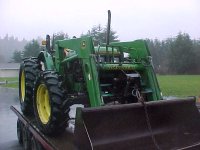CCI,
My TC has an oil Cooler, not sure about the yanmar
Pascal's law applies to static situations (non-flowing) <A target="_blank" HREF=http://www.svce.ac.in/~msubbu/FM-WebBook/Unit-I/PascalsLaw.htm>pascal's law</A>
Fluid Dynamics 101
Pressure (psi) and flow (gpm) are inter-related and depend on several factors.
#1: Pump performance curve, usually given as Pressure vs. flow. For a given pump The higher the pressure the lower the flow & the higher the flow, the lower the pressure
#2: Plumbing: Size of pipe, surface finish etc. Larger pipe will allow more flow for a given pressure. Or, to get the same flow out of a smaller pipe, you have to increase the pressure. All pipe has pressure loss associated with it, X psi per unit length.
#3: Restrictions: We often talk about "reducing the flow" or "restricting the flow" The missing part is for a given pressure. If you could bump up the system pressure, you can get back to the original flow rate. As a restriction reduces the flow, the pressure rises. What you "hear" is the pressure relief valve operating as you exceed the designed system pressure.
A flow reducer is an intentional restriciton. If it is calibrated it will indicate X GPM at Y Pressure. If it is adjustable, you will find that it closely follows the pump performance curve. A well designed flow reducer will divert the excess back to the reservior.
One thing to keep in mind, is that due to the conservation of mass, the flow is the same everywhere in the system. it doesn't start as 10GPM at the pump and come down to 3GPM at a restriction, it is 3GPM everywhere. (unless you have parallel circuits, but that's a lesson for a different day).
OK, lesson is over. Bottom line, the quick connectors are designed to be as unrestrictive as possible thus they should have no problem powering your winch. They should also have a rating; Ie 10GPM at 2000psi with 5psi pressure drop. Where does the pressure go? As other's have mentioned mostly heat.
Edit here:
A note regarding heat. The pump is what puts energy into the fluid. If you crank up the pump, but don't flow any fluid, you get alot of heat as it is stiring up the fluid that isn't going anywhere. Most (if not all tractors) return the fluid to the reservoir if no circuits are energized (Open Center). Keeping thngs cool.
CCI is correct regarding too much fluid towards an attachement, then you get excess heat buildup. Basically the attachment is a restriction that isn't returning the excess flow to the reservoir, it is increasing the pressure is the system. the relief valve blows, but doesn't flow enough fluid & the pump starts cooking the oil.
So size your pump to the winch or get a flow reducer that returns fluid to the reservoir.
